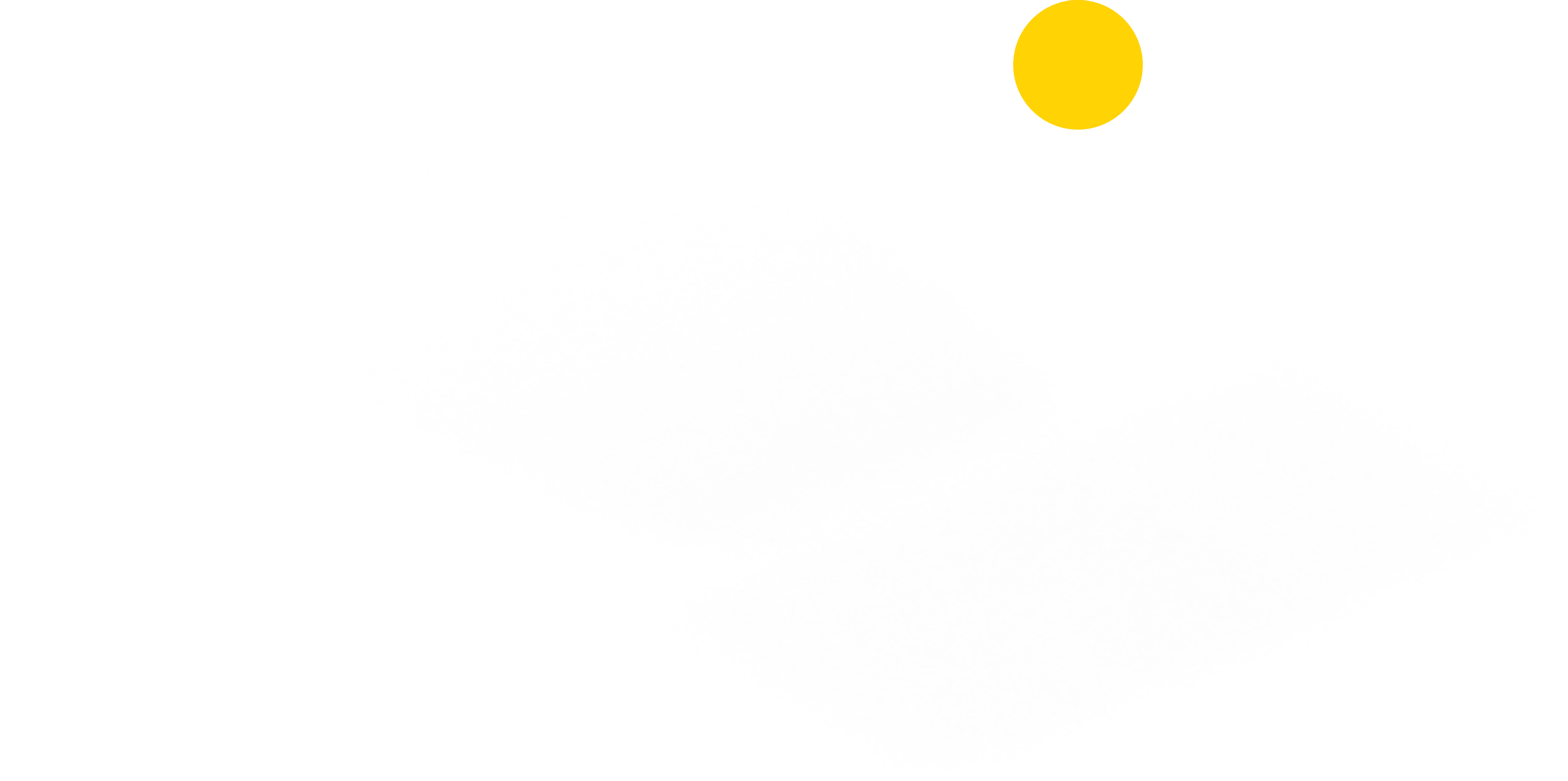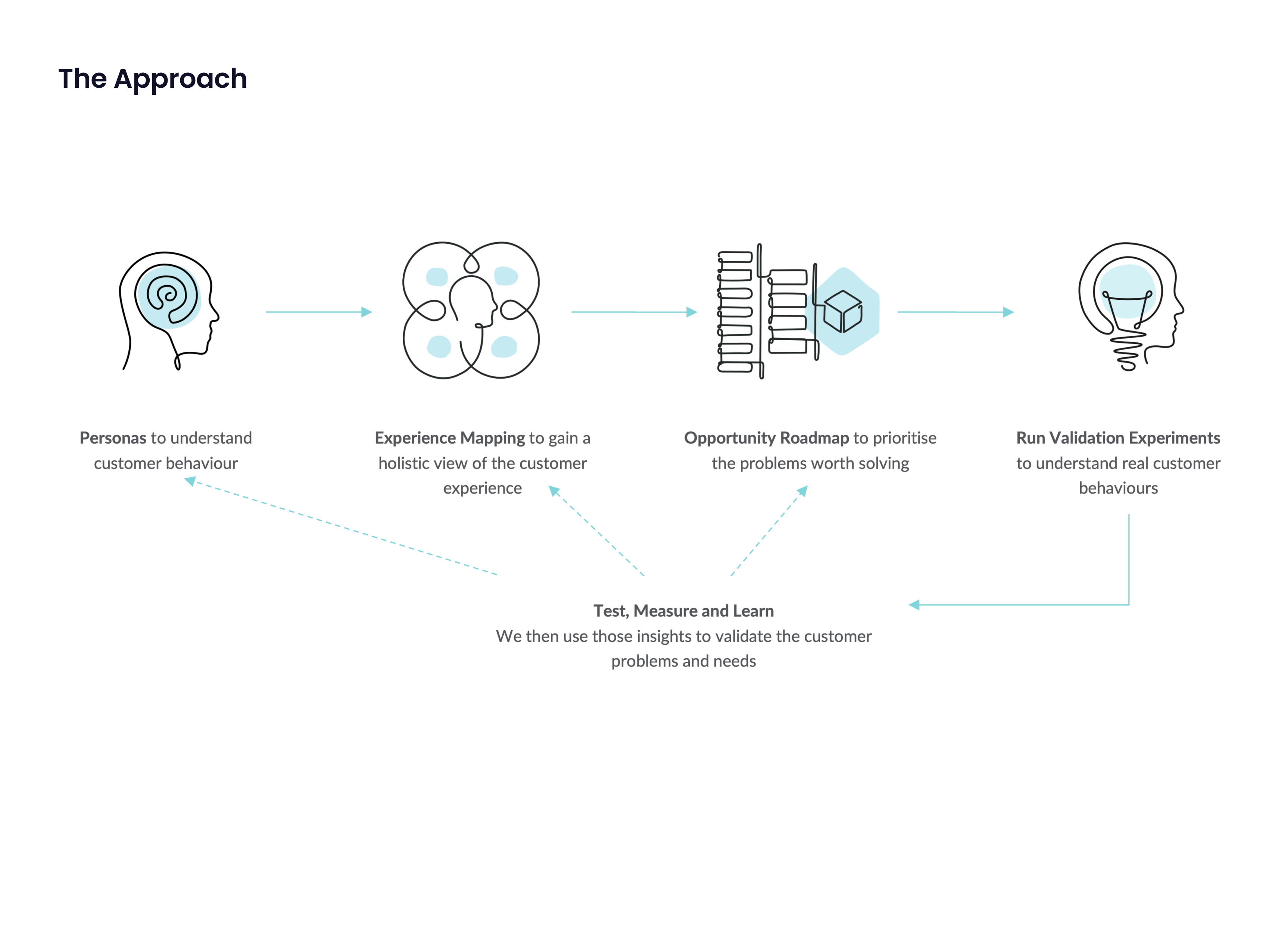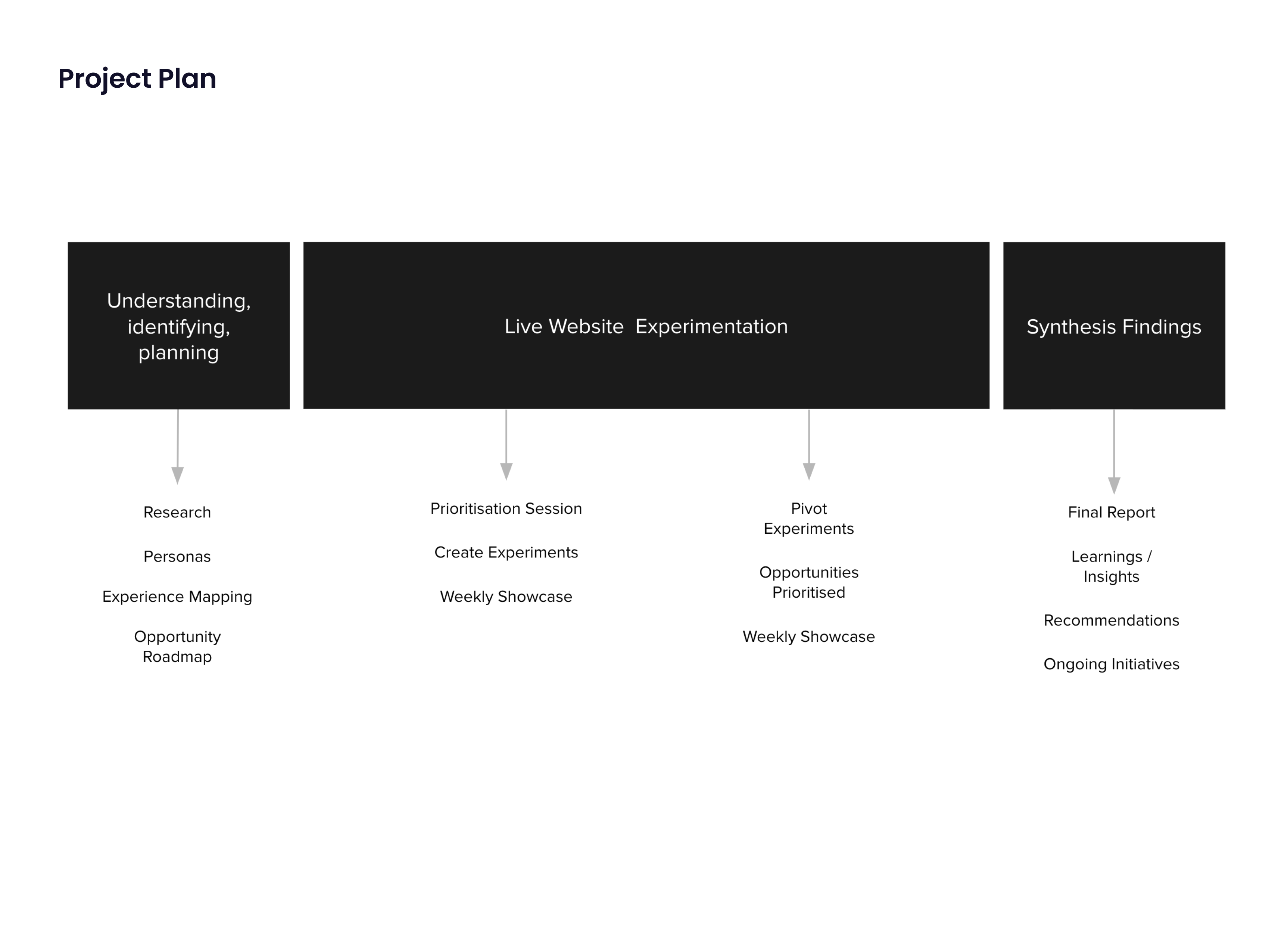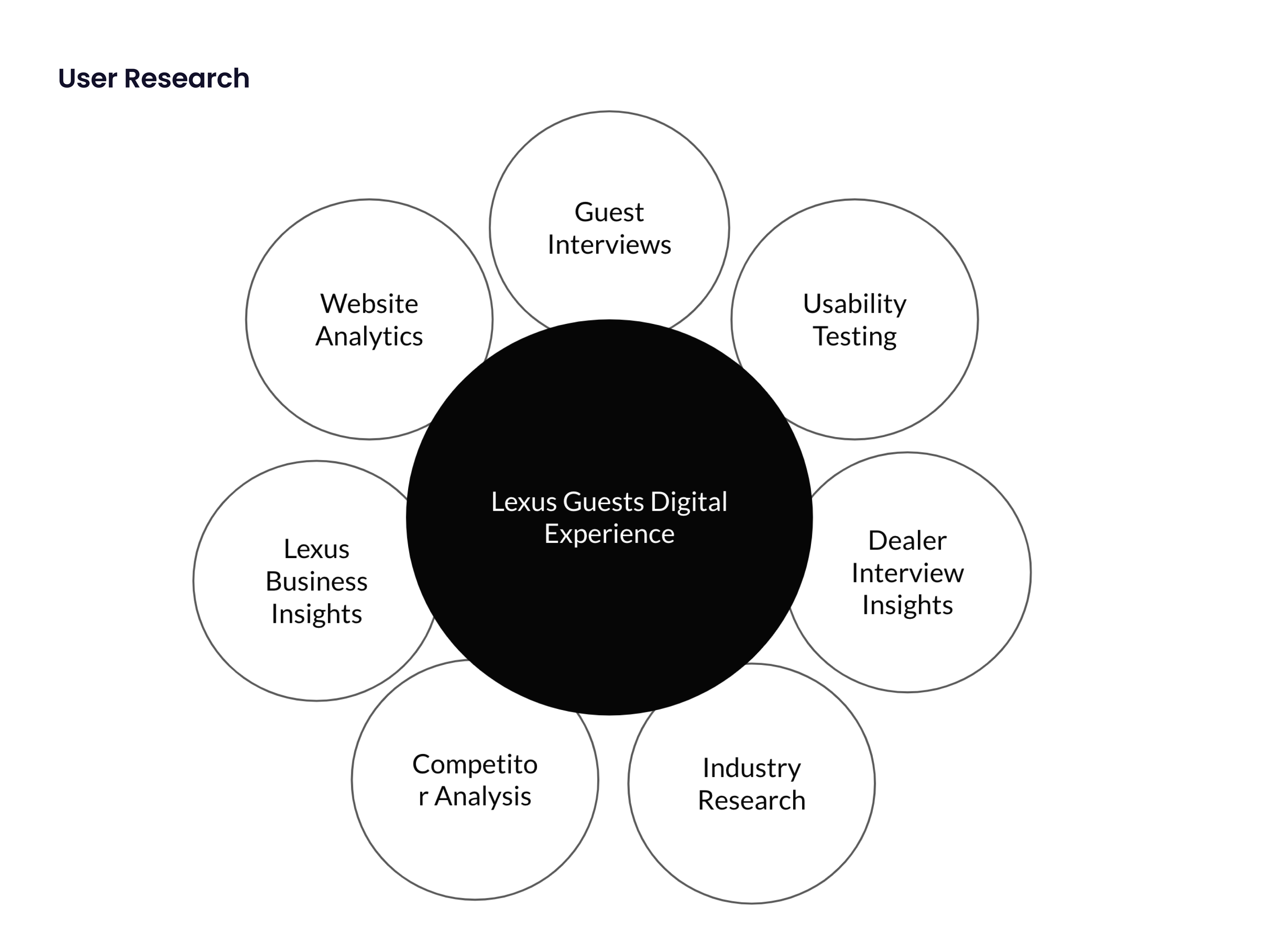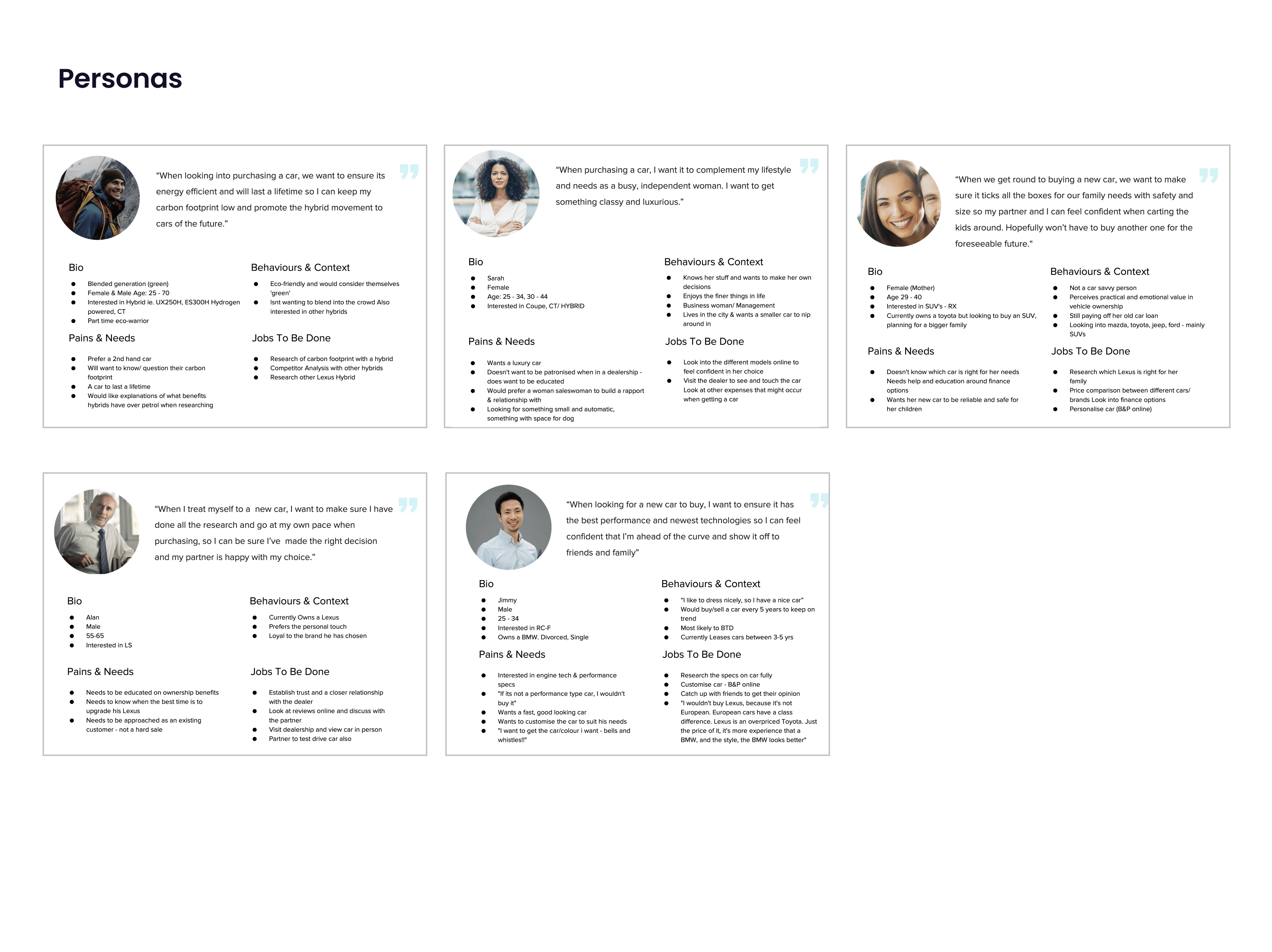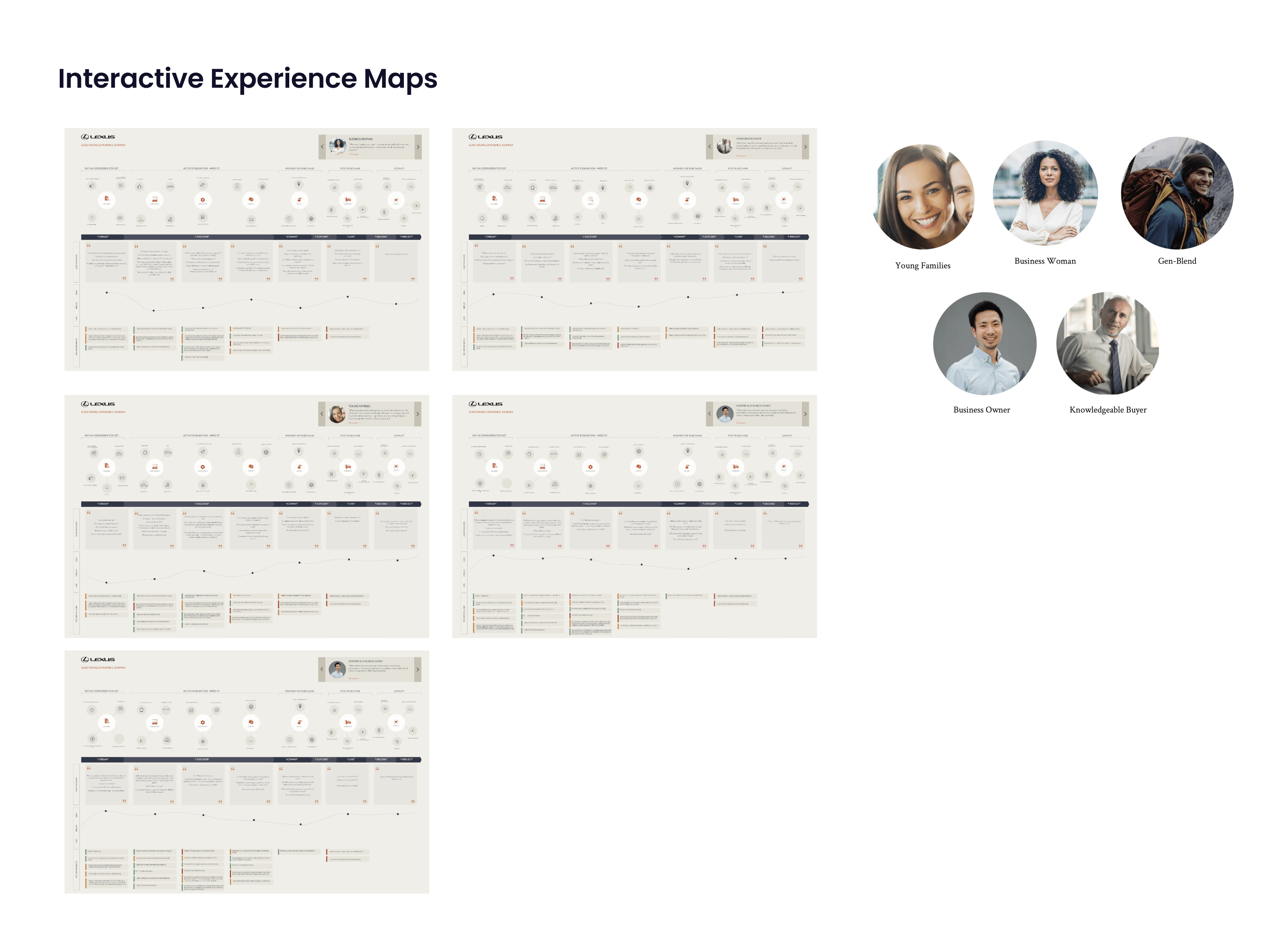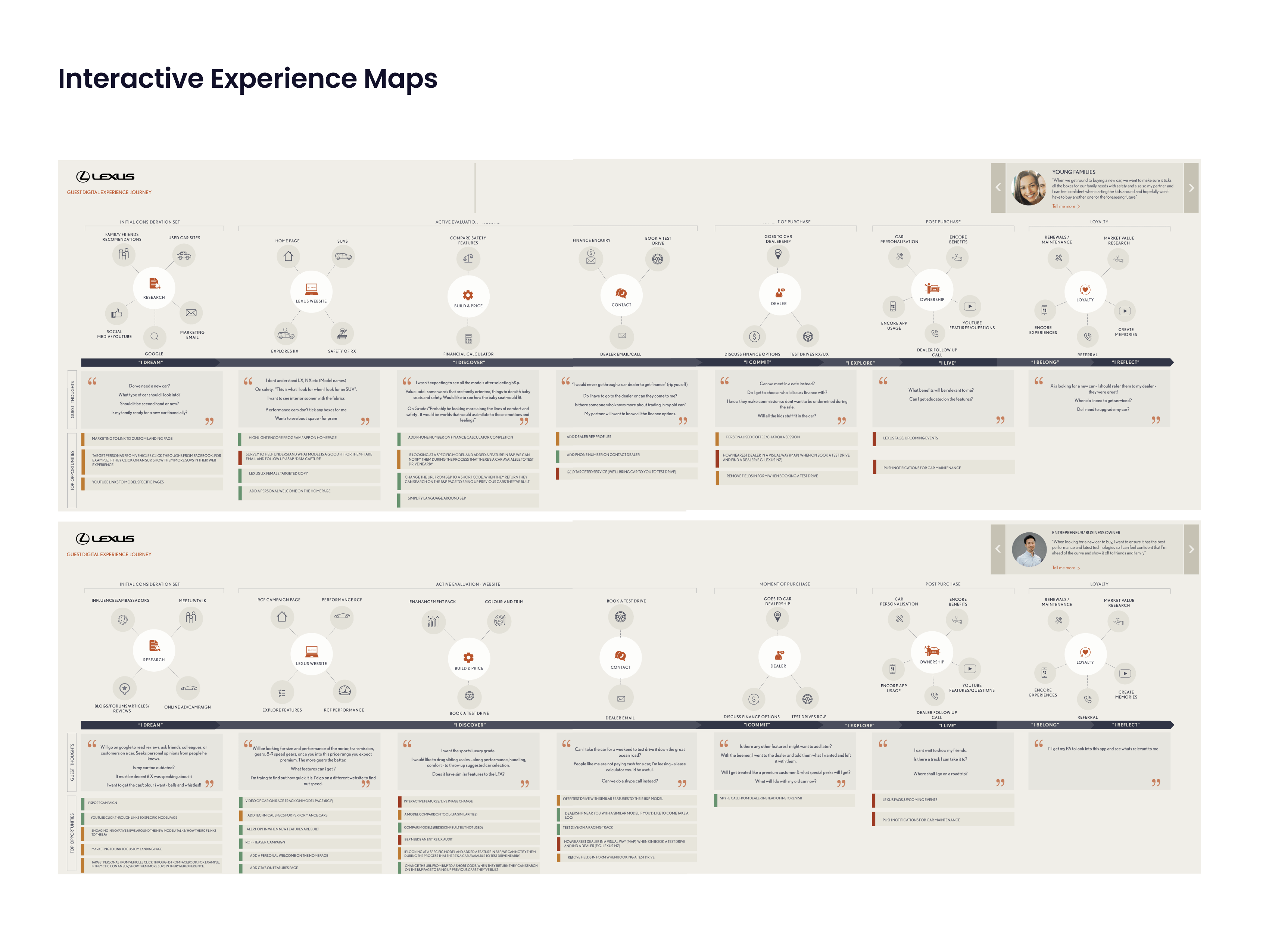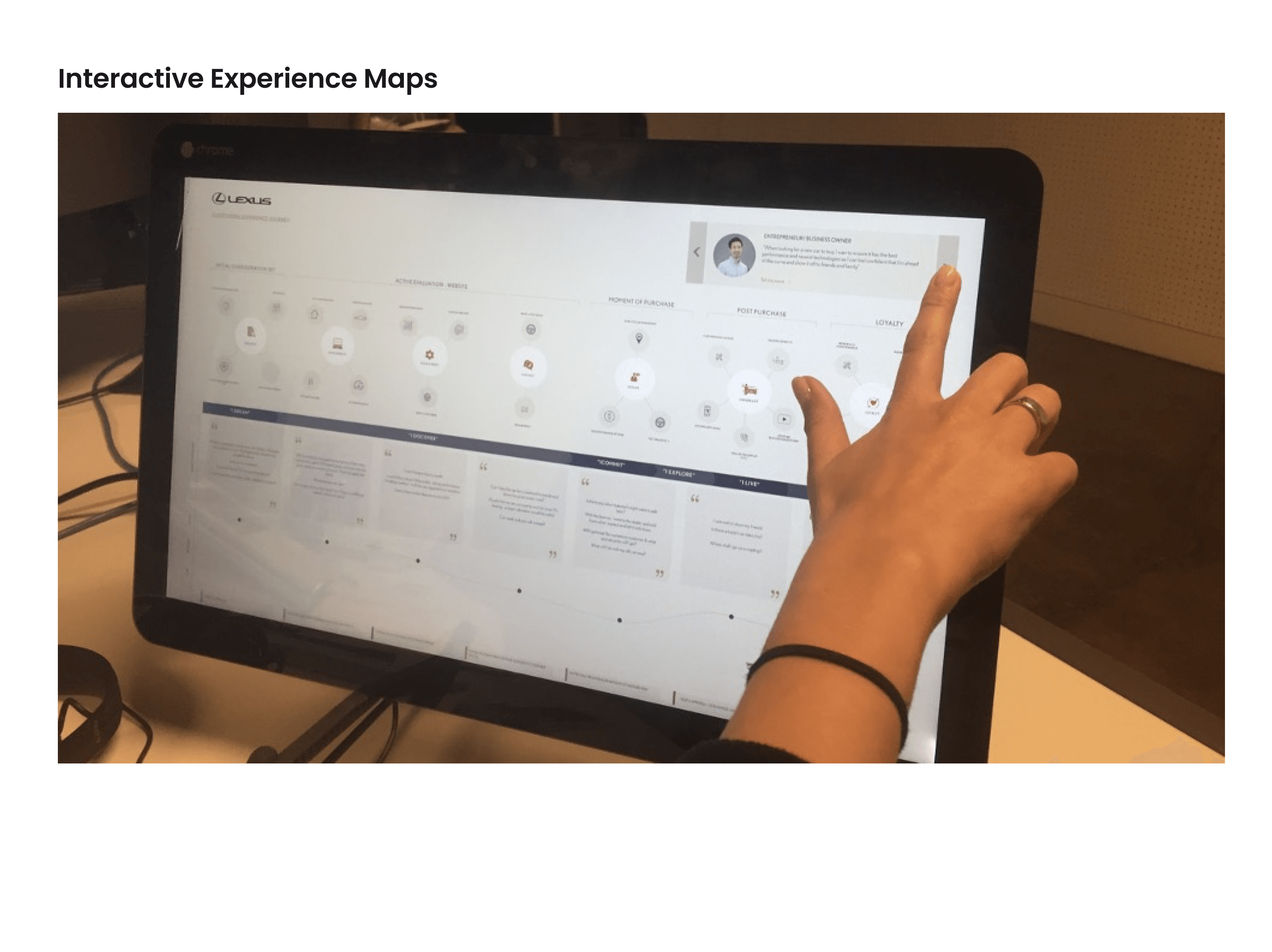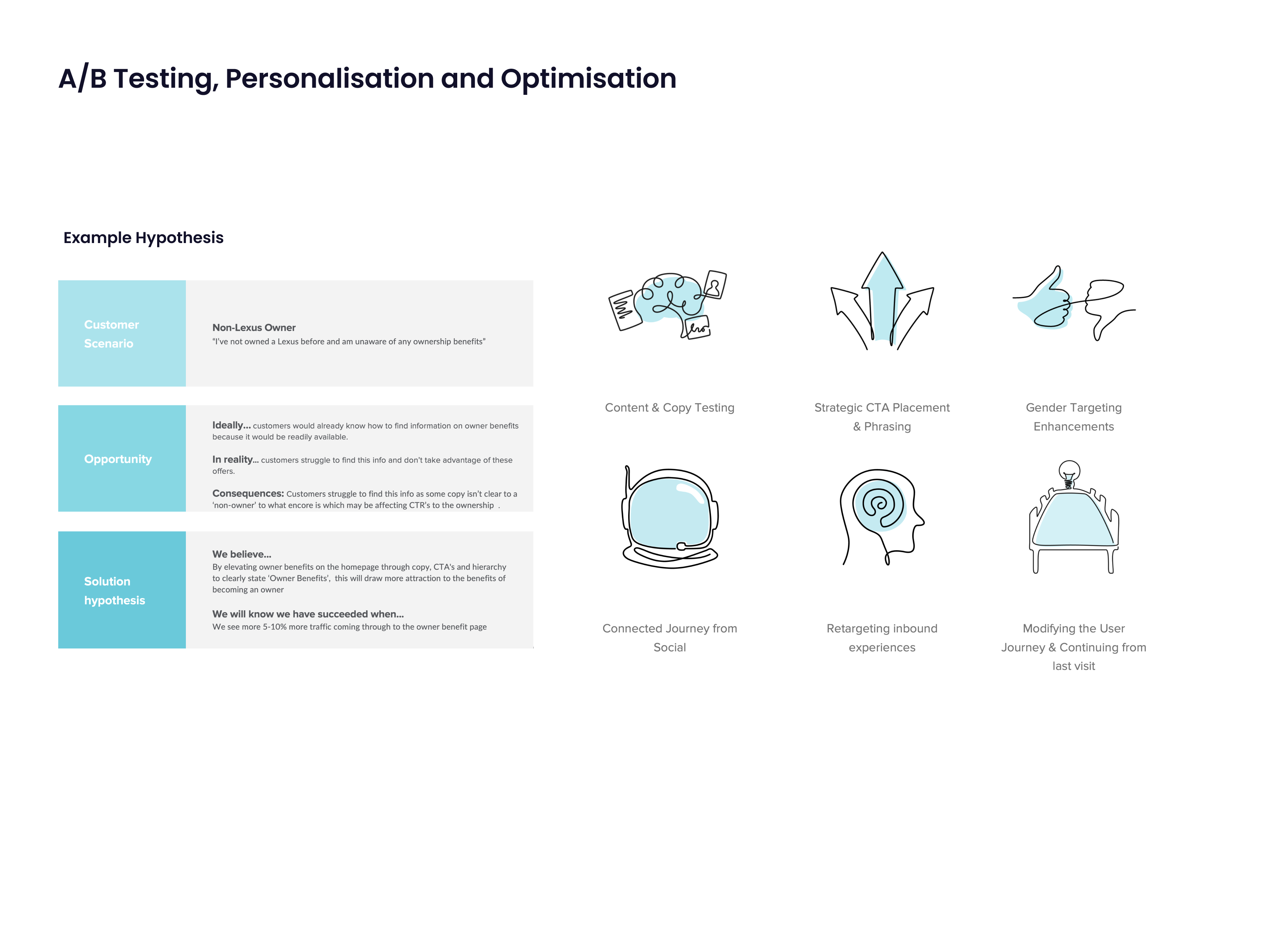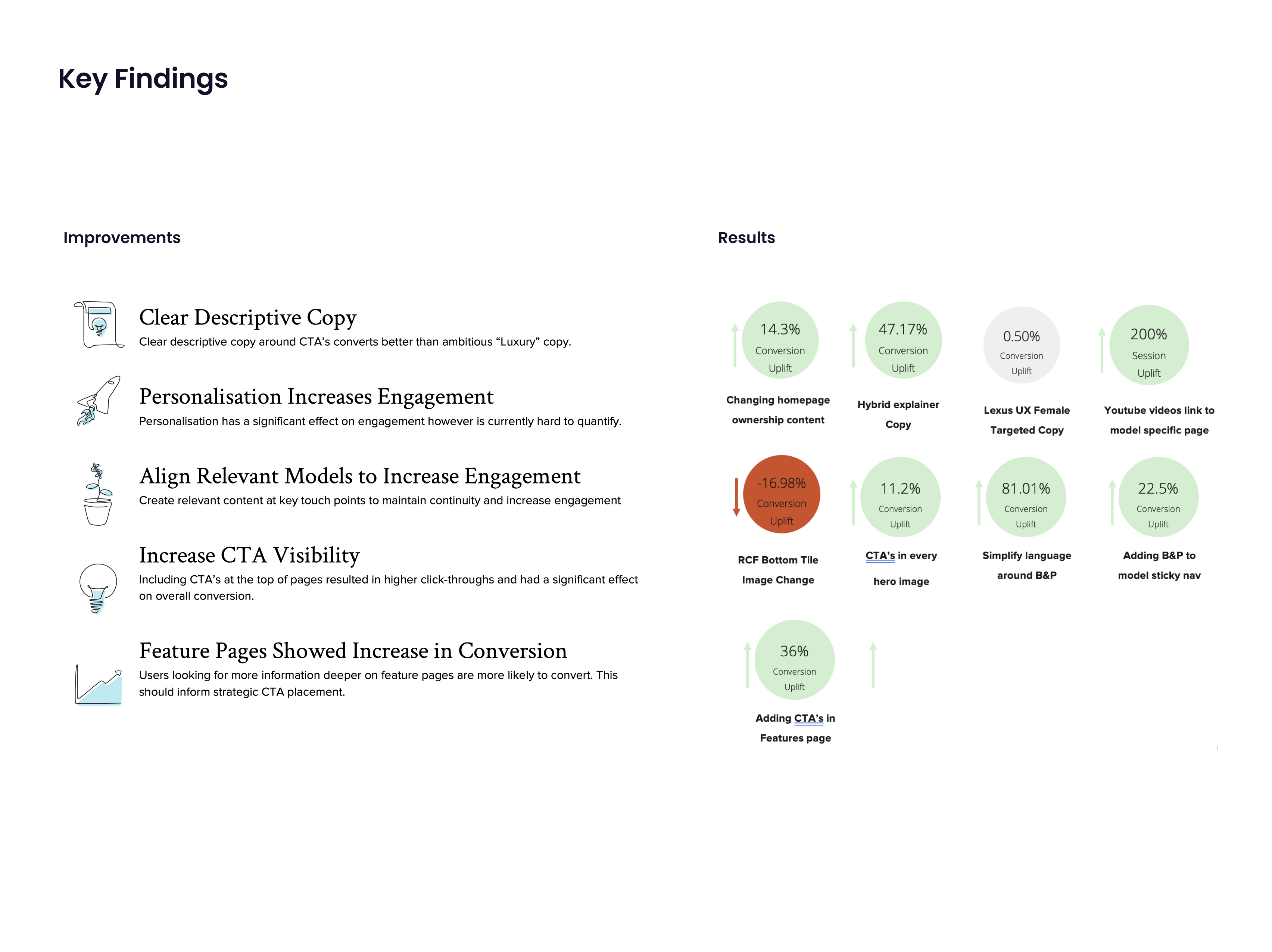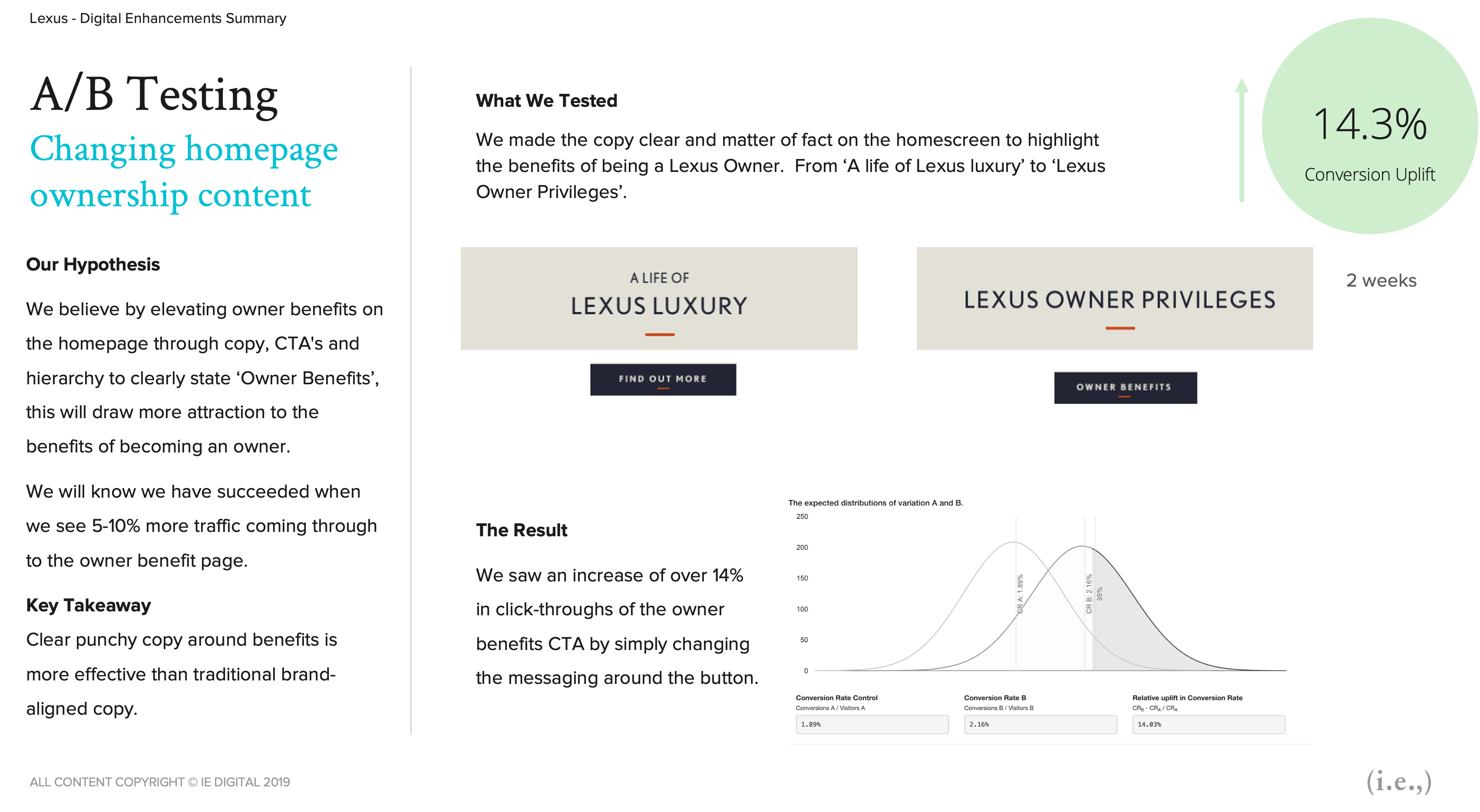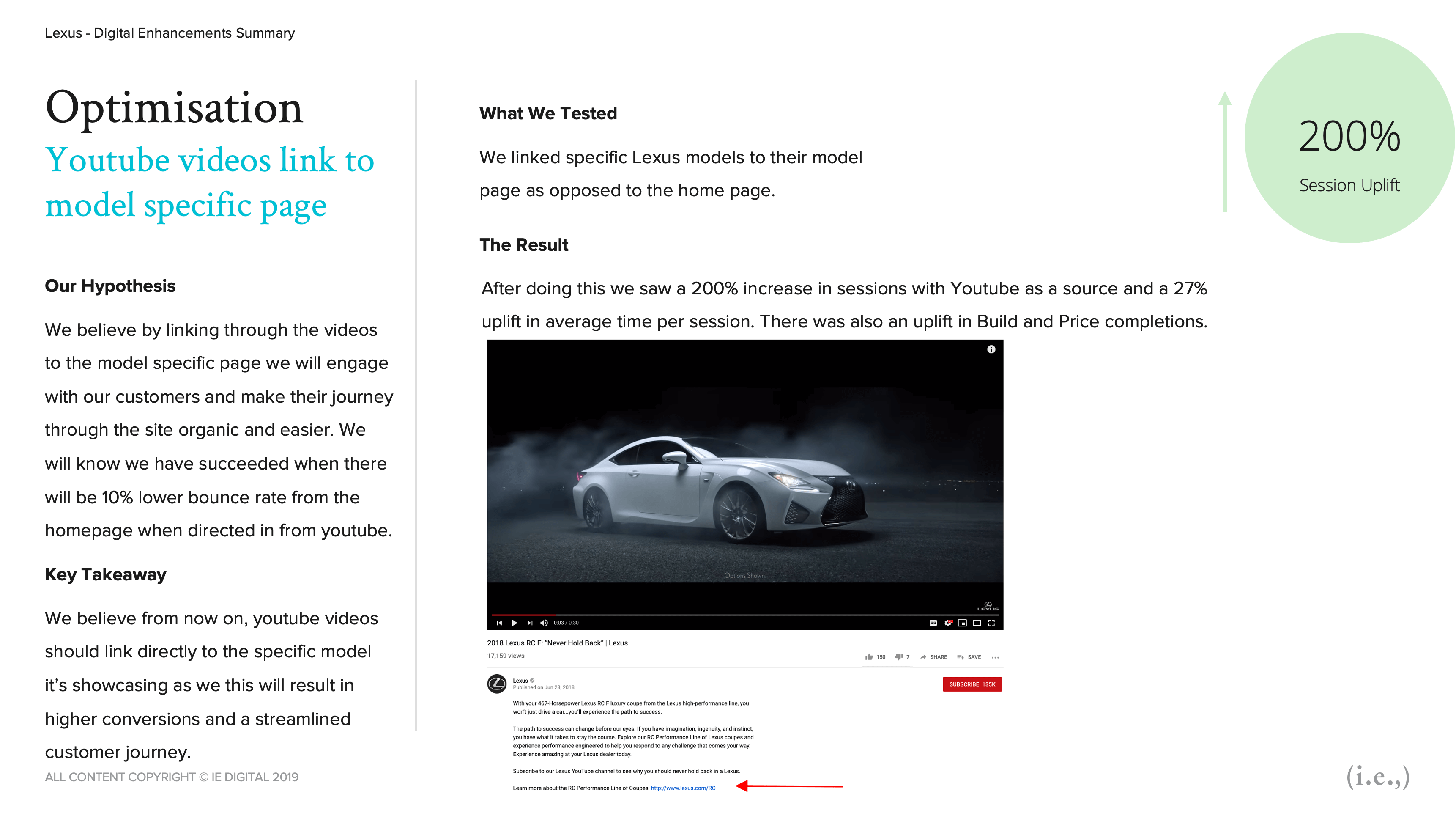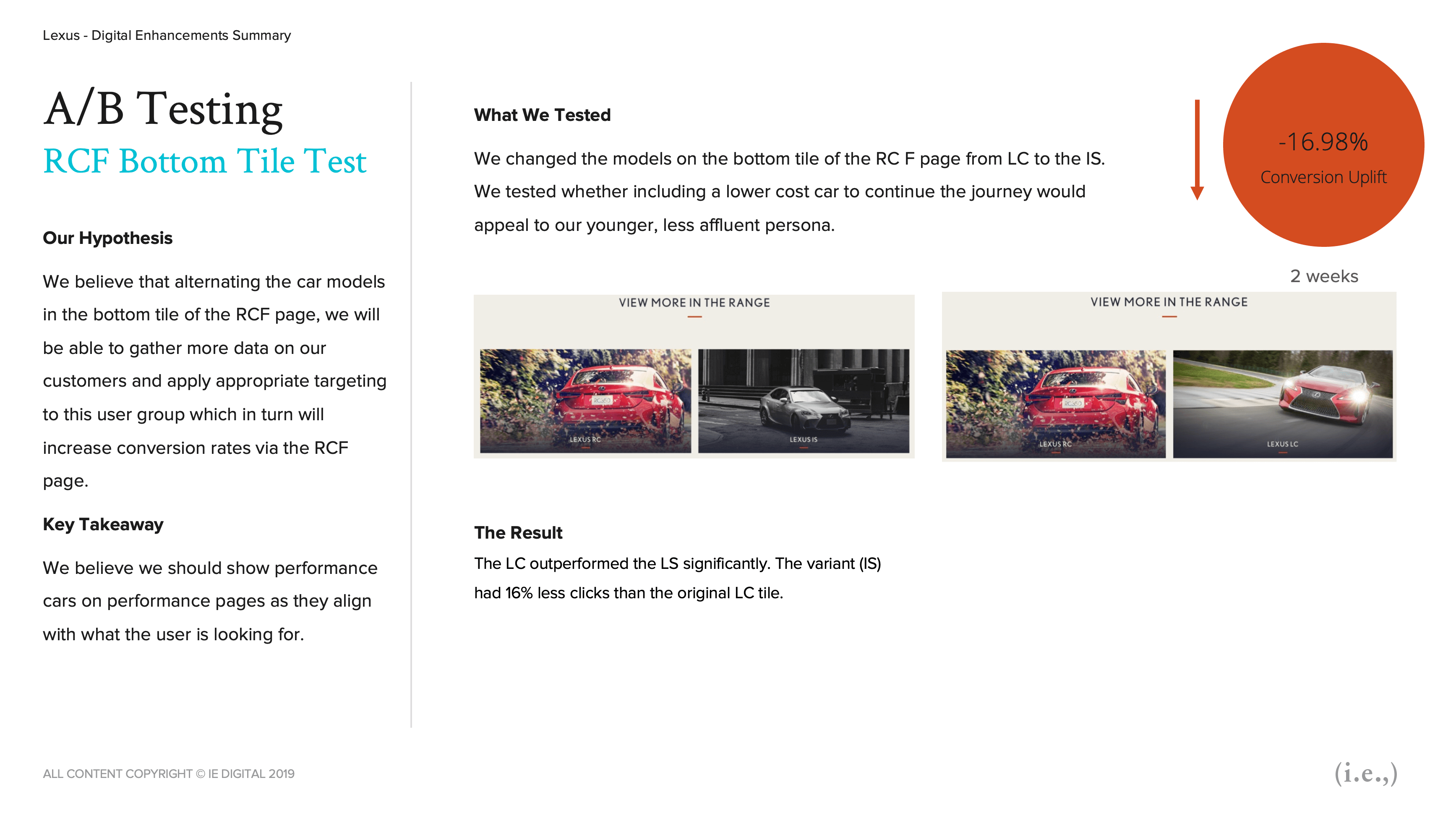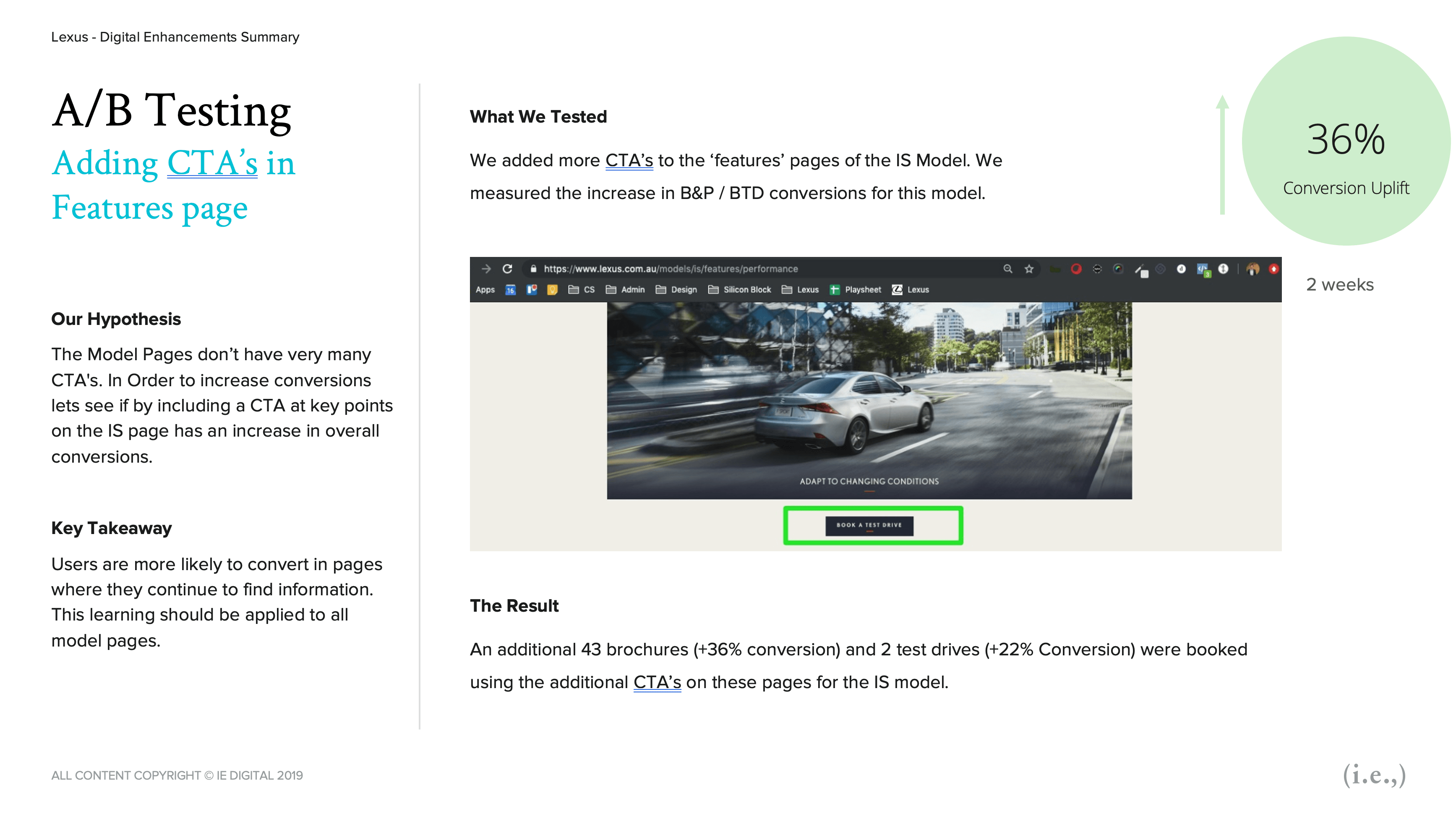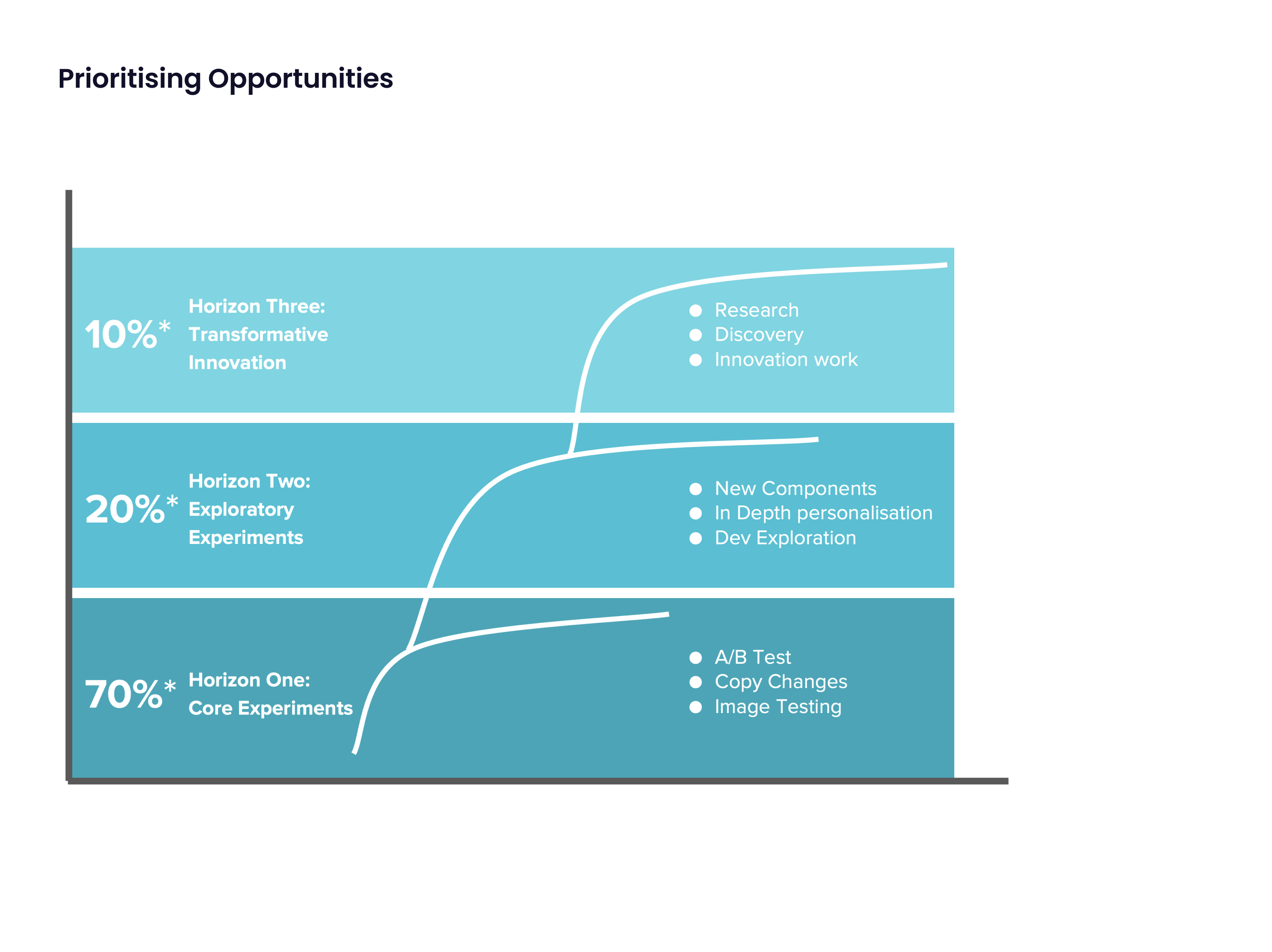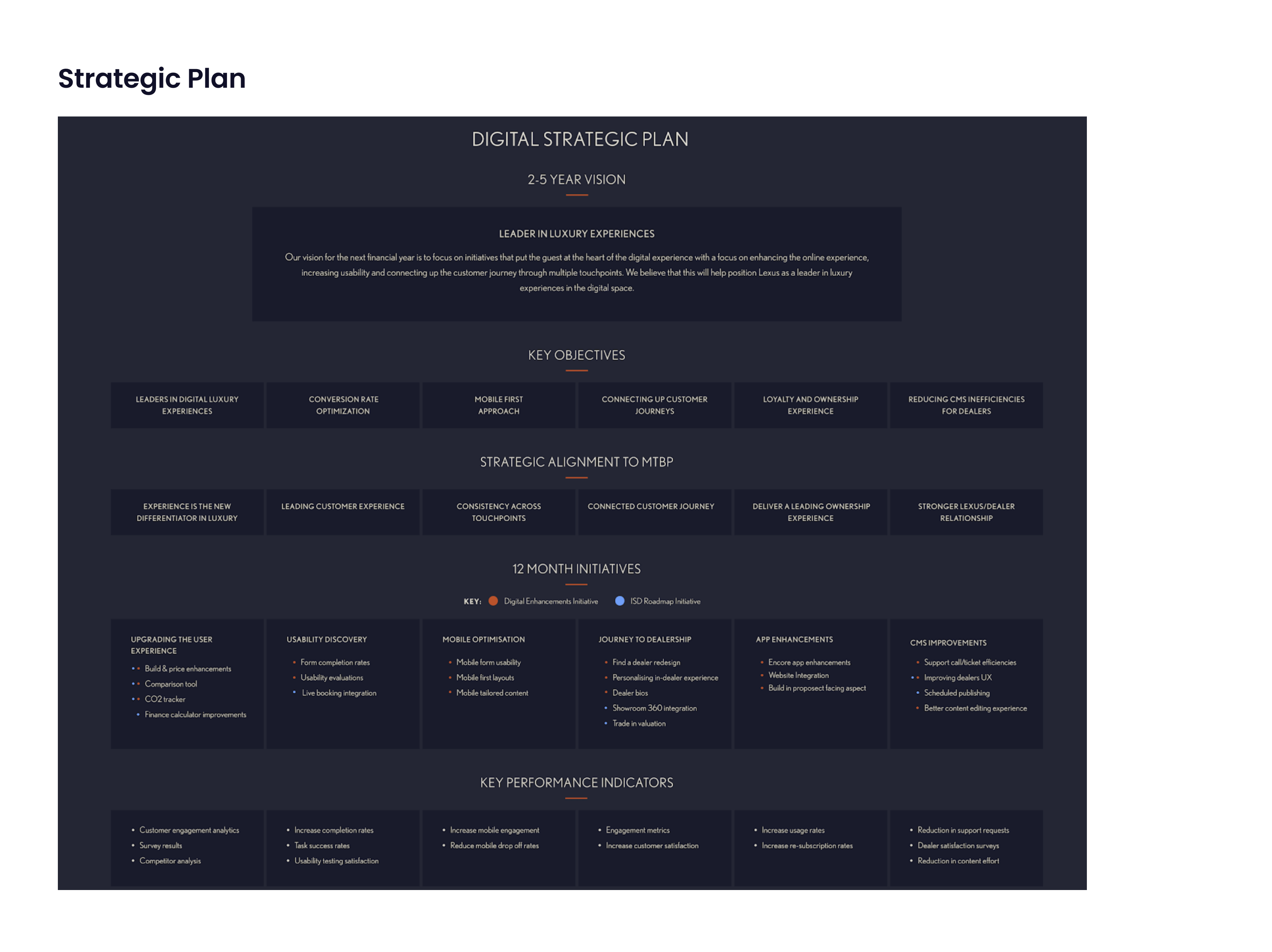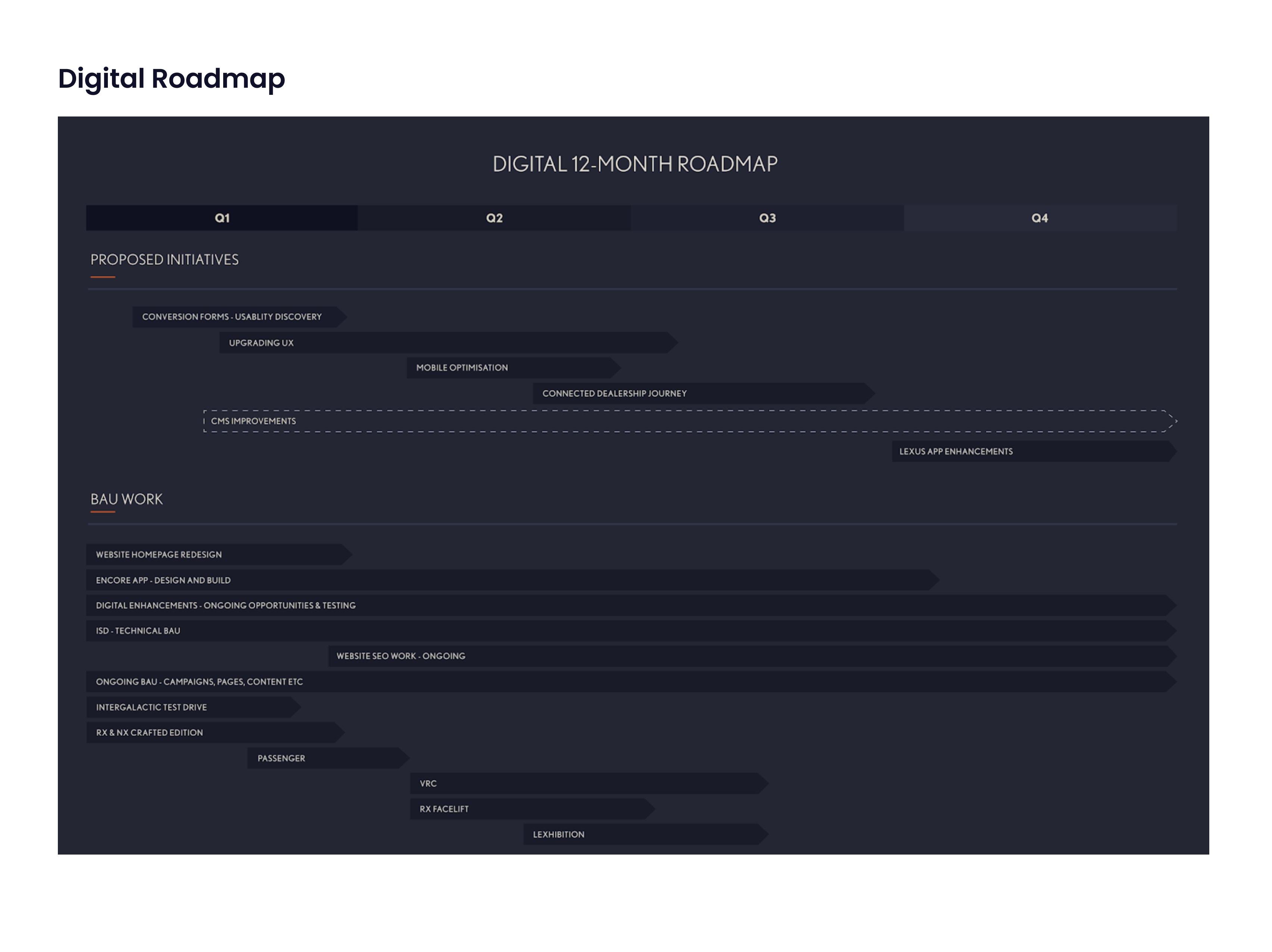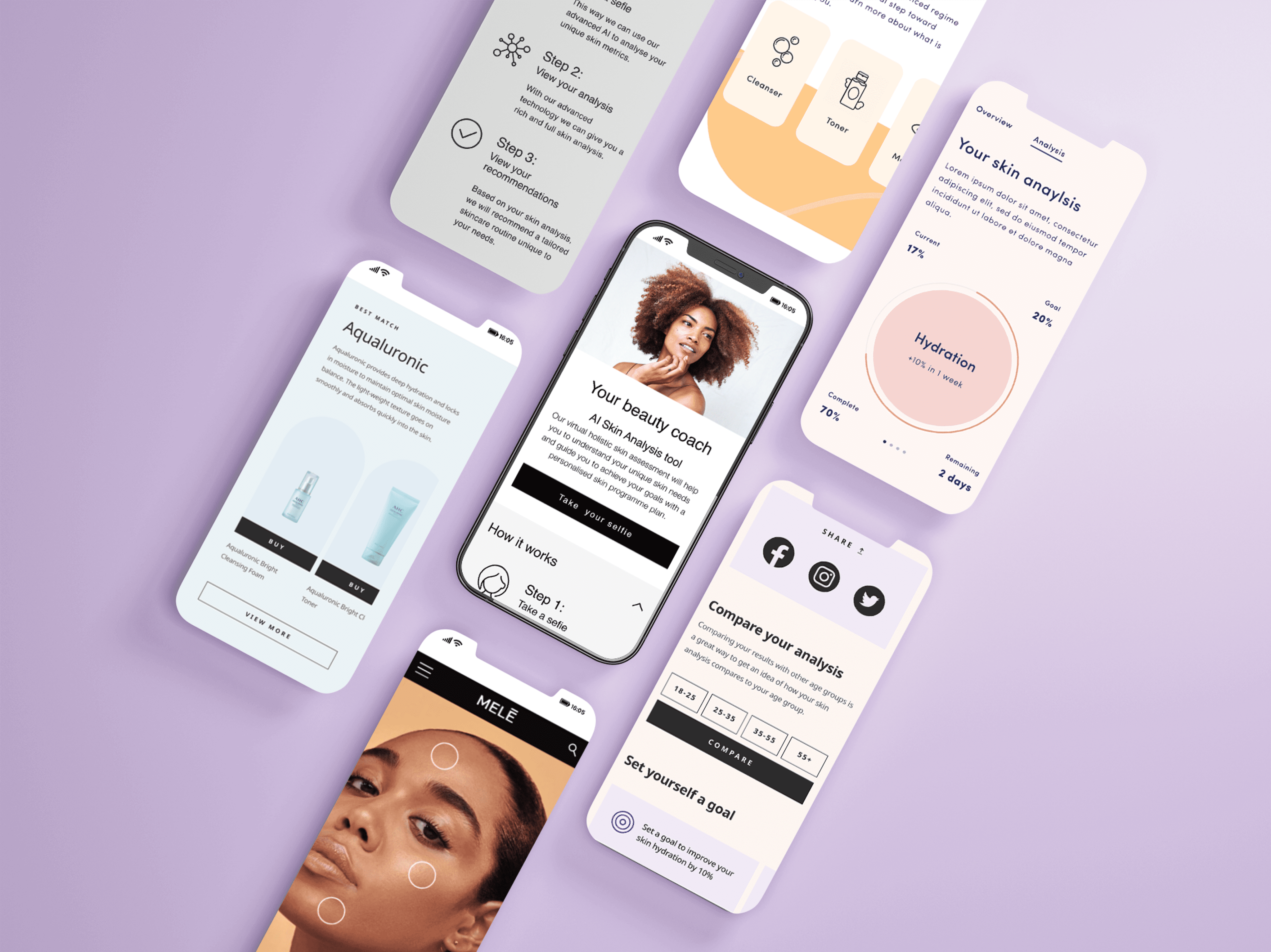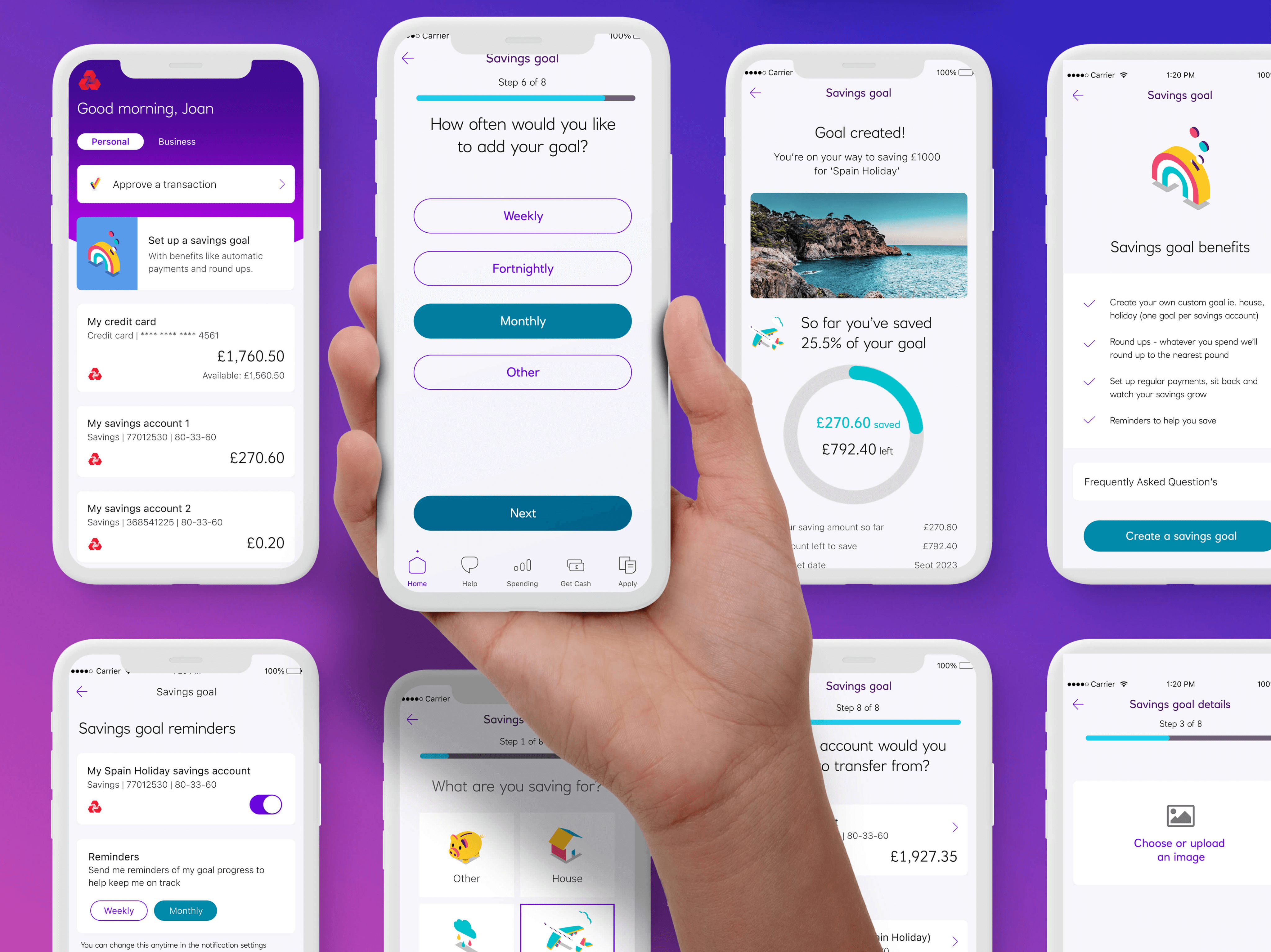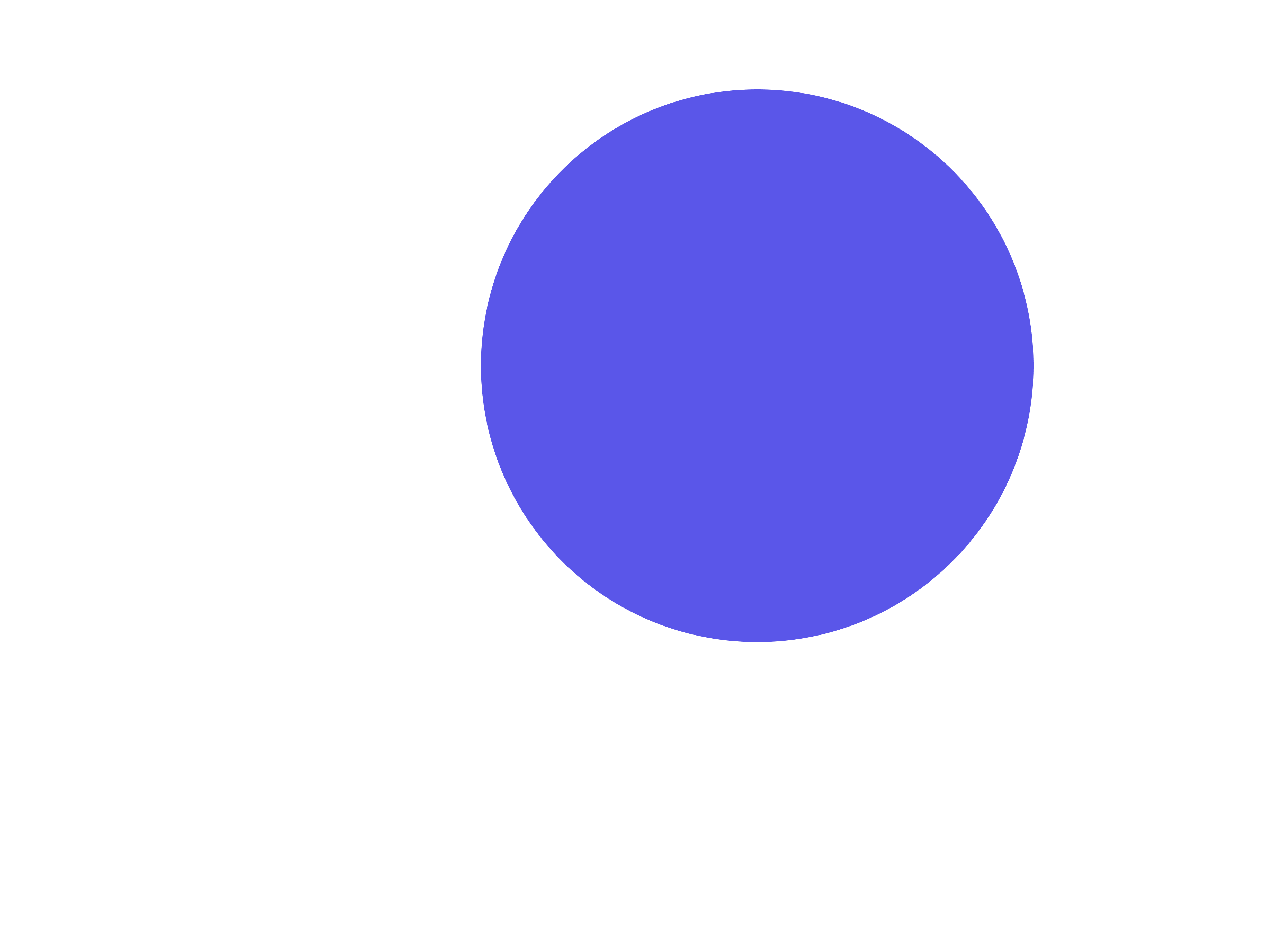Lexus - Digital Strategy
- CX Stragegy lead
- Leading custome research
- Leading UX/UI team members
- Customer experience mapping
- Digital roadmap
- CX Stragegy lead
- Leading custome research
- Leading UX/UI team members
- Customer experience mapping
- Digital roadmap
How Might We: Help Lexus to create a customer-centric digital enhancement approach through ongoing initiatives and improvements.
Lexus Australia previously had no digital strategy in place and were instead conducting ad-hoc projects for improving their website and apps. This meant that projects were often last minute and done reactively without holistic thinking of the overall strategy. Seeing this opportunity, we decided to create a strategic plan to align and guide the projects and initiatives.
My roleI led the approach and direction of the project, creating the engagement design, running workshops with my UX team, leading customer research, synthesis and creating the experience map as well as the strategy plan and roadmap output. The content strategist worked more closely on the detail of the experiments, whilst I led the hypothesis and opportunity identification.
Shape of the team- CX Strategy Lead (myself)
- Senior UX designer
- Account Manager
- Content Strategist
- Group Director
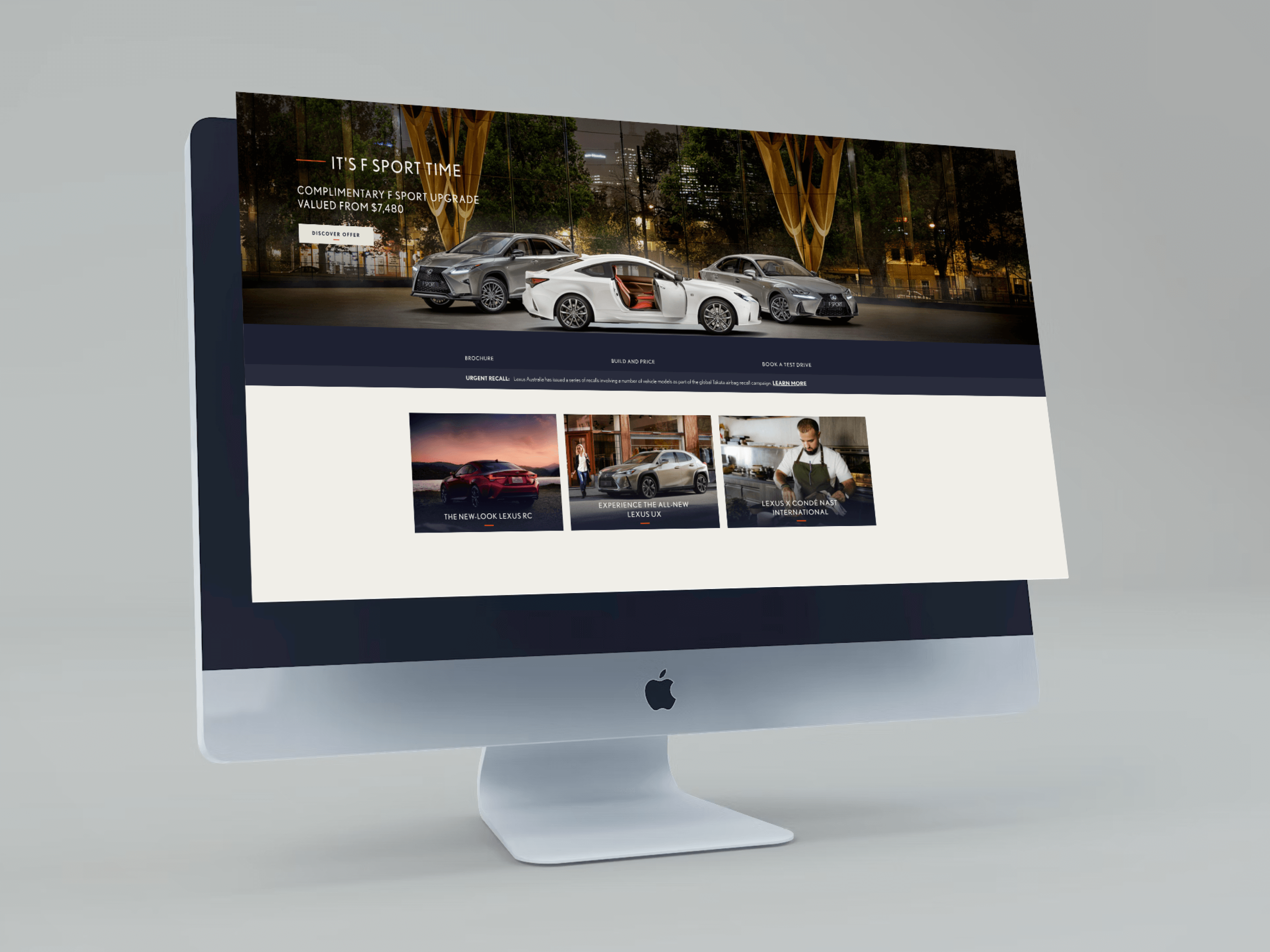
Creating an engagement approach
We wanted to ensure that our approach was based on understanding the users, through research, data and analysis that we could then map out to understand opportunities for enhancements to inform our strategy. But we didn't want the strategy to be something that was a set and forget, we wanted this to be an ongoing methodology ingrained in the ways of working that would be a constant flow of testing, measuring and learning.
Some of the activities included:- Workshops to gather data and define existing personas & journeys.
- Customer experience mapping to identify and prioritise opportunities.
- Weekly experiment showcases to inform the next set of experiments.
- Reports based on data with our synthesized insights, recommendations and ongoing initiatives.
Who are Lexus website customers (guests) and what are their needs?
Whilst Lexus had personas created by their marketing team, we wanted to understand the full view of the customer from different lenses to really understand their online behaviour as well as offline experiences. To do this we interviewed guests (5 x Lexus profile customers), we interviewed some of the local dealers, as well as Lexus business leaders. We then looked at the demographic and data on interactions from the website, as well as conducted usability testing on the existing website with Lexus Guests. This gave a collection of rich insights that allowed us to create personas as well as an end to end experience map.
Once we had gathered and synthesised all the data points and insights, we were able to create an informed view of the customer experience for each persona. We created 5 experience maps to visualise the car buying journey end to end for each persona. This focused on those customers that used the Lexus website during their active evaluation stage. We then brainstormed and prioritised opportunities for each person's individual journey based on the data.
Creating an Interactive Experience MapOften, we see experience maps as being a stand-alone deliverable that can often be forgotten about and not updated. So I came up with a solution which was to create the experience maps in Figma as an interactive tool. This then has the experiments and opportunities as a living, breathing document that can be updated with the progress and outcomes. This was put on a link so that anyone from Lexus could check in on the progress at any given time. We also set this up on a screen and put it in the Lexus offices so that people walking past could interact with it and learn more about the customer and the work we're doing. View interactive map here
How do we use this knowledge to improve the user experience?
From the research, we had a lot of opportunities come out and unmet needs discovered. So from this, we conducted a workshop to understand what is the customer scenario, what is the opportunity and what is the solution hypothesis.
What experiments can we run to test our hypothesis?
We then prioritised these opportunities to understand which ones could be run easily, such as content and copy A/B testing on the live site, to which ones involved more complexity, such as discovery of usability issues in the online forms.
Some of the quick experiments included:- Rewording the copy to highlight the environmental benefits
- Changed YouTube videos to link to model specific pages
- A/B testing model imagery (ie. performance vs luxury)
- Adding menu items into sticky navigation such as build & price
- Adding CTAs on header banners
How can we prioritise and plan which experiments to do and when?
We conducted a workshop to prioritise the experiments and opportunities into 3 horizons.
Horizon One - Core Experiments
The first time horizon, has a clear focus on the core functions of the product. These experiments focus on small tweaks and changes to optimise the current content.
Horizon Two - Exploratory Experiments
New experiments are explored, which may require more effort. This comprises of new components or other tasks that would require further investigation.
Horizon Three - Transformative Innovation
Moving beyond measuring current users' behaviour, this work involves exploring unknown areas and innovative new practises to help inform the previous two horizons.
How can we continuously improve and enhance over the next 3-5 years?
Working with the Lexus team, we discussed each opportunity and how it aligns with their midterm business plan as well as their strategy for the next 2-5 years. I led the creation of a digital strategic plan which would list all initiatives and then feed into a roadmap of the prioritised work for next year.
Results
This new digital strategy and way of working was really well received by the client and got them excited about the future enhancements and experiments. They were impressed with the innovative solution of a interactive experience map that they could use on the touch screen in their offices. Within the first 4 weeks, we had already completed 20 enhancement, A/B tests and personalisation experiments on the website.
- First 7 weeks
- 10-15 interviews conducted
- Over 300 data points
- Over 100 experiments and ideas
- Enhancements Completed: 20
- Enhancements Scheduled: 16
- Enhancements in Backlog: 61

